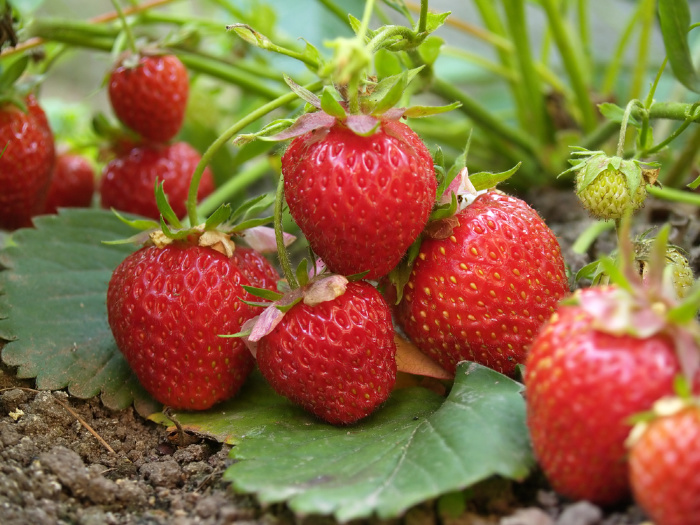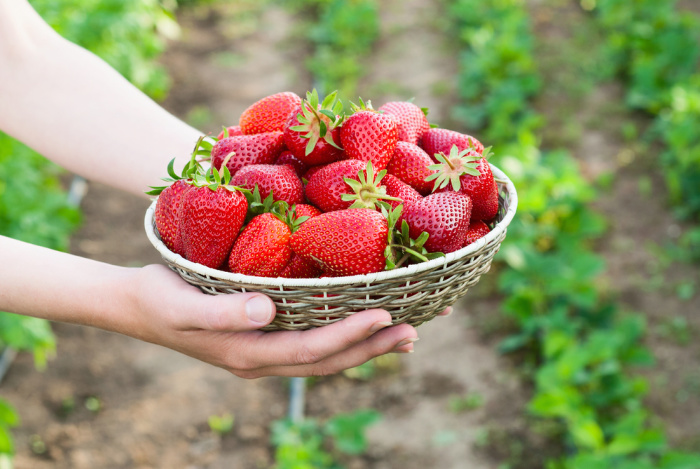Strawberries: Everything You Need to Know

There are many reasons to get excited when spring starts to peek around the corner. Not only are warmer temperatures well on their way, but it’s finally growing season, and it’s only a matter of time before strawberries are at their prime once again. I can’t wait to dive into strawberries: everything you need to know.
Think of the strawberry pies topped with whipped topping, the strawberry shortcakes, or the delicious jams you will be making. You may prefer to eat them just the way they are, and that’s good too.
But how much do you know about strawberries and the health benefits that they bring? Here’s a closer look at strawberries and everything you need to know about them. My favorite Strawberry Slicer to use.
Strawberries: Everything You Need to Know

Strawberries come from a plant called the Fragaria that’s part of the rose family. The modern strawberry that we enjoy today is a man-made hybrid that came from a smaller wild strawberry that had a much shorter shelf life, but arguably a better flavor and aroma.
Strawberries were first recorded in Rome around 234 BC, but North and South America were in abundance with them when explorers from Europe laid eyes on them for the first time in the late 1500’s and early 1600’s.
After they were taken back to Europe, it was the French who created the hybrid later on in the 18th century that we enjoy today. I love learning more about strawberries, everything you need to know.
Fun Facts
Did you know that strawberries are the only fruit where their seeds can be found on the outside? Because of this, strawberries are not considered to be a berry, which are known to have their seeds on the inside. These seeds are actually dried fruit, while we enjoy eating the “receptacles” part of the plant.
Most strawberries have as many as 200 seeds on them. They also happen to be a perennial plant that you can enjoy its fruit every year, for about five years. Strawberries are the first fruit to ripen in the spring.
California grows as much as 2 billion pounds of strawberries every year, which equates to about 80% of all the strawberries grown in the United States.
The Romans in ancient times believed that strawberries had medicinal powers. They used them to treat sore throats, bad breath, kidney stones, and even for depression.
Varieties
There are over 103 different varieties of strawberries out there. All of them come in different sizes, shapes, and even colors. For the most part, they are red, but they also may be pink, white, or even blue. Check out these most popular varieties.
Honeoye
The Honeoye is considered one of the heaviest producers. For the most part, they are consistently larger in size and bright red in color.
Earliglow
The earliglow strawberry ripens sooner than almost any other variety. The berry size is medium to large, with a tough dark red outer wall. They are more resistant to most strawberry diseases and have a sweeter flavor, making them an excellent variety for canning.
Ozark Beauty
The Ozark beauty is the most popular of all the varieties. It grows large yields of fruit, sometimes even two crops per year, depending on the region. They are definitely sweet, but their popularity is due to the number of strawberries that they produce.
Allstar
The Allstar strawberry is mildly sweet, with a beautiful red fruit that can sometimes be quite large, making it a favorite among many gardeners.
Jewel
The jewel strawberry is an excellent quality berry, with strong skin and a red large and wide wedge shape to the berry.
Tristar
This variety is very sweet, a medium-sized berry that comes conical in shape. It’s good for eating fresh and also for freezing.
Sparkle
The sparkle strawberry is considered to be the best variety for jam-making that comes medium in size. It’s easily among the favorites.
Nutritional Facts
In a single serving of strawberries, (about 8) there are around 49 calories and 12 grams of carbs (3 of these are fiber). They contain an excellent amount of vitamins C and K, along with manganese, folate (vitamin B9), potassium, calcium, and important antioxidants. A single serving also has as much as 51.5 mg of vitamin C, which is almost half of your recommended daily value.
Health Benefits
Provides an Immunity Boost
Because strawberries are so rich in vitamin C, they can help to give your immune system an extra boost and protection to ward off any free radicals that can do your body harm.
Reduces the Risk of Cancer
With the presence of vitamin C and other antioxidants, strawberries can help prevent and reduce the risk of certain types of cancer. The ellagic acid that’s in them is able to aid with suppressing cancer cell growth.
Lowers Cholesterol
Antioxidants can help your heart in a number of ways. They can lower bad cholesterol and provide you with an anti-inflammatory effect for your heart. Strawberries may even help to reduce the risk of diabetes and heart disease.
Reduces Inflammation
Eating foods that are high in antioxidants and phytochemicals can actually reduce inflammation. This is especially helpful for people who suffer from arthritis or have joint pain.
Regulate Blood Pressure
Strawberries have a decent amount of potassium, making them a good source for not only regulating blood pressure but lowering it as well.
Improves your Skin
Vitamin C helps to produce collagen in our bodies, especially as we get older. By eating foods that are rich in vitamin C (like strawberries), people are able to enjoy healthier, and younger-looking skin.
Helps Eye Health
The antioxidants in strawberries may actually help to prevent cataracts. The vitamin C in them also helps strengthen your eye’s retina and cornea and protect against UV rays and damaging radicals.
Storing Strawberries
It’s frustrating every time you go to eat strawberries and there’s evidence of mold that’s beginning to grow on them. You may be storing them wrong. Here’s the best way to store them so that they last much longer for you. It’s best to keep strawberries cool and dry until you are ready to enjoy them.
For starters, don’t wash them or remove their stems until you are ready to eat your strawberries. Rinsing them only speeds up the spoiling. Place them on a tray that’s lined with a towel and then cover it with plastic wrap and put them in the refrigerator.
If they were purchased already in a container, you can leave them this way. Strawberries should last about 3 to 7 days this way. They also taste sweeter when brought to room temperature.
Apples: Everything You Need To Know
Carrots: Everything You Need to Know
Cucumbers: Everything You Need To Know
Final Word
Not only do strawberries taste so good, but they are really good for you too. They can be enjoyed in so many different ways, making them one of the most popular fruits out there.
What surprised you the most about strawberries and any of the health benefits that they bring? What did you think about strawberries, everything you need to know? May God bless this world, Linda
Copyright Images: Strawberry Bush Deposit photos_2179100_s-2019, Strawberries in Basket Deposit photos_47665437_s-2019
The post Strawberries: Everything You Need to Know appeared first on Food Storage Moms.
